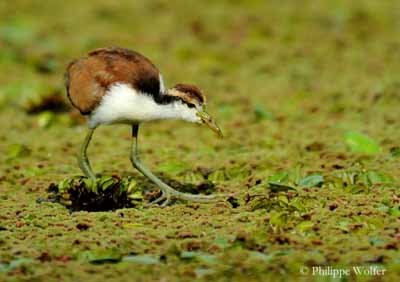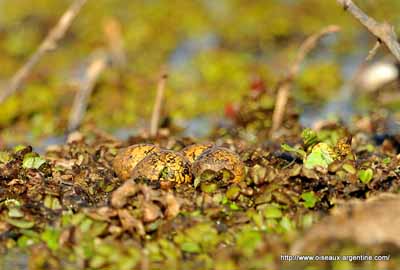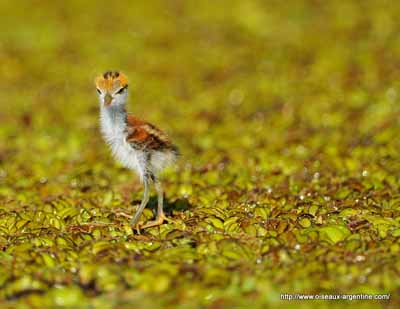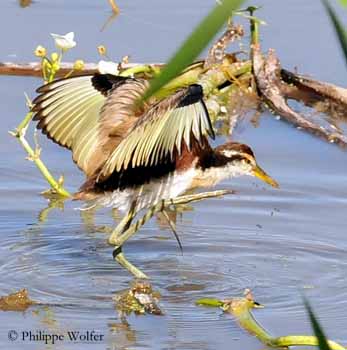
Fr: Jacana noir
All : Rotstirn-Blatthühnchen
Esp : Jacana Suramericana
Ital: Jacana dai barbigli
Nd: Jacana
Sd: Flikjacana
Port: Jaçanã
Photographers:
Alfredo Colón
Puerto Rico Wildlife
Patrick Ingremeau
TAMANDUA
Eduardo Andrés Jordan
MIS AVES – AVES DE ARGENTINA
Philippe and Aline Wolfer
OISEAUX D’ARGENTINE
Text by Nicole Bouglouan
Sources:
HANDBOOK OF THE BIRDS OF THE WORLD Volume 3 by Josep del Hoyo-Andrew Elliott-Jordi Sargatal - Lynx Edicions - ISBN : 8487334202
SHOREBIRDS by Peter Hayman, John Marchant and Tony Prater – Christopher Helm – 1986 – ISBN: 0747014035
L’ENCYCLOPEDIE MONDIALE DES OISEAUX - Dr Christopher M. Perrins - BORDAS - ISBN: 2040185607
A GUIDE TO THE BIRDS OF COLOMBIA by Steven L. Hilty and William L. Brown - Princeton University Press – ISBN 069108372X
Arthur Grosset's Birds (Arthur Grosset)
BirdLife International (BirdLife International)
Wikipedia, the free encyclopaedia
Wattled Jacana
Jacana jacana
Charadriiforme Order – Jacanidae Family
BIOMETRICS:
Length: 21-25 cm
Weight: M: 90-118 g – F: 140-150 g
DESCRIPTION:
The Wattled Jacana is a South American species. Very typical of this family, the long toes are visible as soon as they hatch!

The adult has reddish or chestnut-brown upperparts, including back, upperwing-coverts, and uppertail. The flight feathers are yellowish to pale greenish-yellow with dark brown tips. We can see a bright yellow carpal spur on the bend of the wing.
The rest of the body is mainly black. The underwing is similar to the upperwing, with black carpal area.
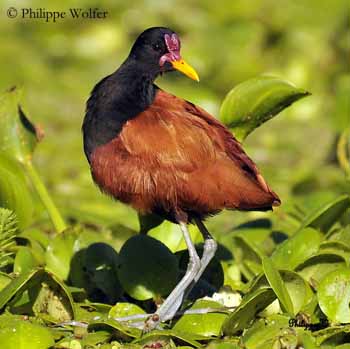
Head and neck are black too. The face shows red bi-lobed frontal shield, and rictal lappets. The yellow bill contrasts strongly with these red ornaments. The eyes are dark brown. The long legs and the feet with elongated toes are pale bluish-grey.
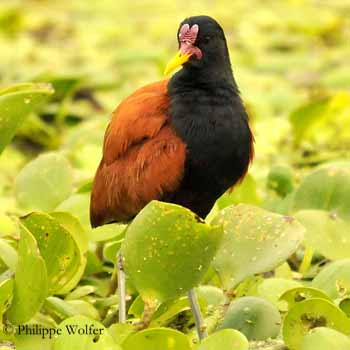
The female has similar plumage, and she is larger and heavier than the male. She has bluish tinge along the upper edge of the frontal shield.
The juvenile has small bi-lobed frontal shield and lacks the rictal wattles. It has dull brown crown and upperparts. The hindneck is black. We can see a conspicuous white stripe extending from the forehead to the nape.
The underparts are white, including cheeks, chin and throat. It has pale yellowish eyes.
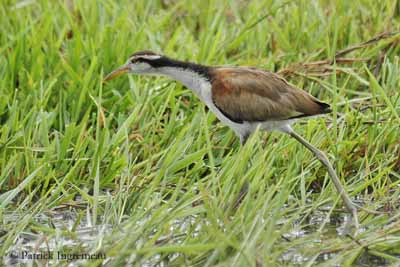
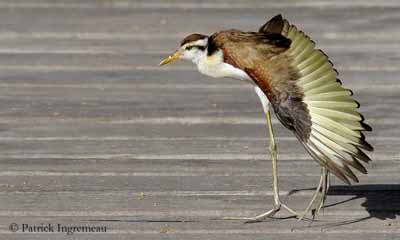
We can find six subspecies which differ in plumage with variable black and chestnut areas.
VOICE: SOUNDS BY XENO-CANTO
The Wattled Jacana is a noisy bird. It utters squeaky, sharp and cackling notes, and also series of twittering sounds “kee-kick, kee-kick”.
Loud and raucous calls are given in front of predators. Between mates, the sounds are soft if they are close to each other, and louder is one of them is absent. Soft notes are also used between male and chicks.
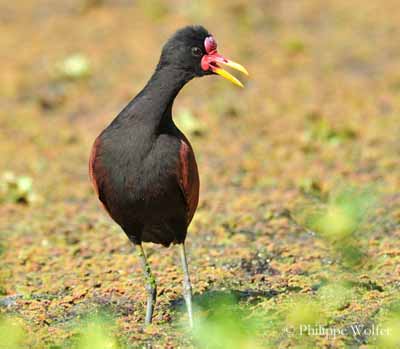
HABITAT:
The Wattled Jacana frequents the freshwater wetlands with floating and emergent vegetation. According to the range, it forages in shallow water, but also in nearby grasslands, cultivated areas and wet meadows.
RANGE:
The Wattled Jacana is present in South America, from W Panama and Trinidad, and southwards, through most of S America, east of the Andes. Some populations occur in NW and NE Peru.
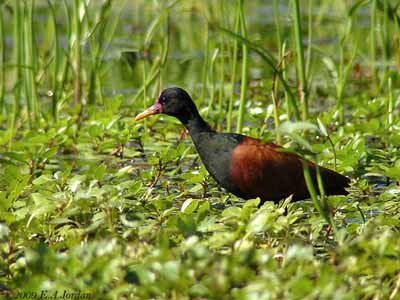
BEHAVIOUR:
The Wattled Jacana feeds mainly on insects and various invertebrates. It may take seeds in some parts of the range such as in Guyana where it forages in ricefields.
The bird walks and runs on the floating vegetation, thanks to the long toes. It gleans for preys from emergent vegetation, and upturns the roots of these aquatic plants to reach invertebrates.
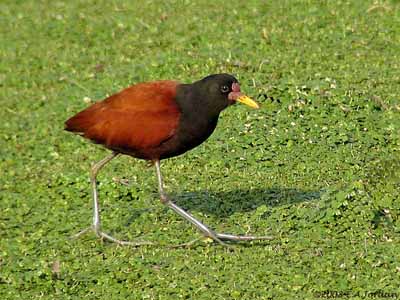
The Wattled Jacana often extends its wings vertically. This is a visual signal in social behaviour, but also a response to invasion of the territory by other species, and to potential threat in the water.
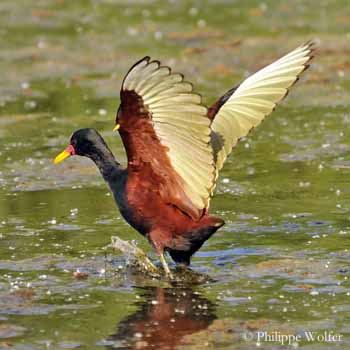
They are territorial during the breeding season, but more gregarious outside this period. They can form large flocks at suitable sites during the dry season.
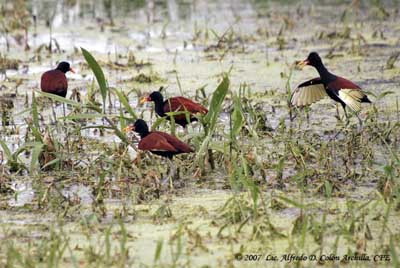
During the breeding season, the roles are reversed. The female breeds with several males and chases away other females and intruders from the territory with the help of the male. After the laying, the male incubates the eggs, feeds and rears the chicks while the female lays other clutches with other males at one week intervals. She can kill the chicks reared by a male to mate with him.
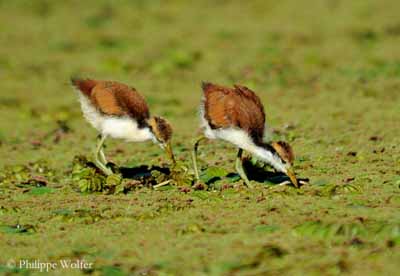
The Wattled Jacana is sedentary within its wide range. Some local movements occur during the dry season to find water.
FLIGHT:
The Wattled Jacana has direct flight, and often soars low above the water.
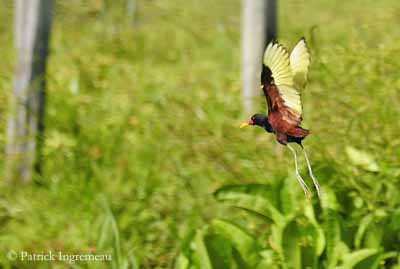
REPRODUCTION:
The nest of the Wattled Jacana is small and often partially submerged. It is made with stems and aquatic plants. The nest is usually built by the male, but the female may assist, performing nest-building movements and picking-up some pieces of vegetation.
She lays 4 eggs. The incubation by the male alone lasts about 28 days. It also accompanies the precocial chicks, but they are able to feed themselves. The male broods and protects them. The young remain with him during several weeks, and they can breed at 1-2 years old.
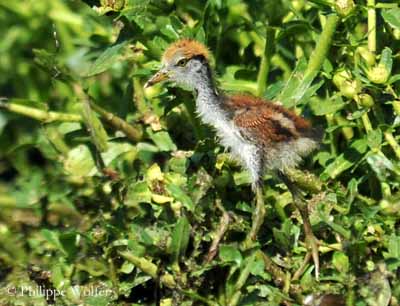
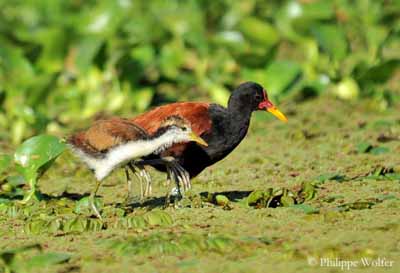
DIET:
The Wattled Jacana feeds mainly on insects and various other invertebrates. According to the range, it may also take some seeds in ricefields.
PROTECTION / THREATS / STATUS:
The Wattled Jacana is threatened by habitat loss, drainage of wetlands and human disturbances. However, the development of pastures and grazing lands and their small associated reservoirs has increased the habitat in most parts of South America.
The species is not currently threatened.
